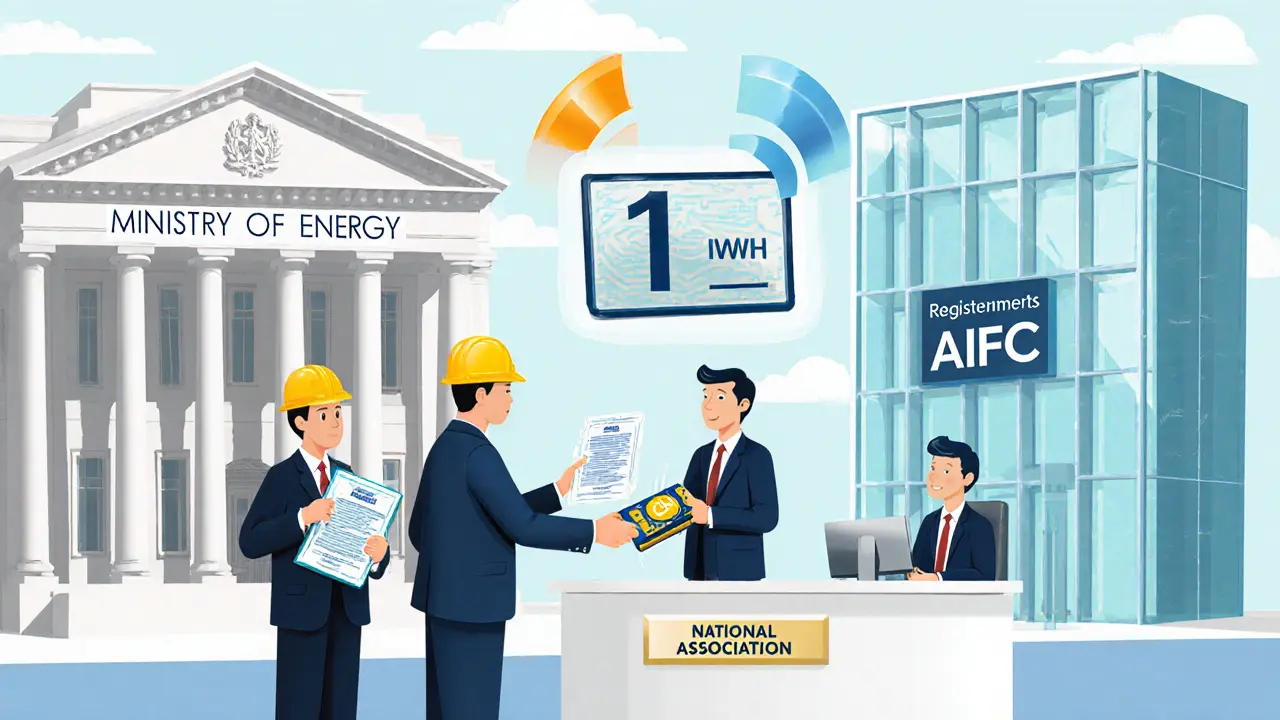 Sep, 6 2025
Sep, 6 2025
Kazakhstan Mining Profit Calculator
Calculate your potential mining profits under Kazakhstan's current regulations. Enter your hash rate, electricity cost, and coin price to see how the 15% tax, 1 MWh electricity limit, and 75% sell-through requirement impact your bottom line.
Kazakhstan's 1 MWh electricity limit: Max 1 MWh per transaction
State-mandated electricity platform required
75% of mined coins must be sold on AIFC platform
2% tax rebate for renewable energy users
Results
Transaction Limit: 1 MWh per transaction
Your operations would require 0 transactions daily
When it comes to Kazakhstan cryptocurrency mining is the practice of using the country’s power grid to generate digital coins, most famously Bitcoin, under a legal framework that changed dramatically after a severe energy crisis, miners now face a new set of rules. The shift from a boom‑town haven to a tightly‑controlled sector happened fast, and anyone looking to start or keep a mining operation must understand the why, what, and how of the current regime.
Why the Energy Crisis Triggered a Regulatory Overhaul
Between 2019 and 2021, Kazakhstan surged to the top of the global Bitcoin hash‑rate rankings. Low‑cost electricity, mainly from coal‑fired plants, attracted dozens of large farms that relocated from China and the United States. By early 2022, the country topped the world in mining power, but the rapid influx strained the national grid. Residential neighborhoods, hospitals, and critical industries experienced rolling blackouts, and in some regions power consumption by miners rivaled the needs of entire cities.
The turning point came in the summer of 2024 when illegal farms siphoned enough electricity to leave over 1million people without reliable service. Government officials declared a state of emergency, and the Ministry of Energy announced temporary cuts to mining‑related loads during peak hours. Those cuts proved insufficient, prompting a comprehensive legislative response.
Who Controls the Landscape: Key Government Bodies
The regulatory ecosystem now involves several agencies working together:
- National Bank of Kazakhstan (NBK) - oversees financial compliance, AML checks, and the mandatory 75% sell‑through requirement on the AIFC platform.
- Astana International Financial Centre (AIFC) - provides the regulated exchange where most mined assets must be sold.
- Ministry of Energy - runs the state‑run electricity procurement platform and sets the 1MWh per‑transaction limit.
- Financial Monitoring Agency (FMA) - enforces AML, tax reporting, and coordinates raids on illegal operations.
- National Association of Blockchain and Data Center Industry - a newly created industry body that registers equipment and monitors energy use.
Each authority has a clear mandate, and non‑compliance with any one of them can trigger fines, equipment confiscation, or criminal prosecution.
Licensing, Taxation, and the 75% Sell‑Through Rule
Mining is legal, but only after you obtain a Kazakhstan mining license. As of 2025, the government has issued 84 licenses and accredited five mining pools. The application process requires:
- Proof of corporate registration and a signed covenant to comply with AML standards.
- Technical documentation showing the total hash‑rate and energy consumption forecast.
- Agreement to purchase electricity exclusively through the Ministry of Energy’s platform.
- Commitment to sell at least 75% of mined coins on the AIFC‑approved exchange (up from 50% in 2024).
- Payment of a flat 15% tax on net mining revenue, collected quarterly.
The tax rate was introduced in 2022 and remains a key revenue source for the state. Failure to meet the sell‑through quota results in a 10% additional surcharge and possible revocation of the license.
Electricity Purchase Limits: The One‑Megawatt‑Hour Rule
To prevent another grid overload, the Ministry of Energy caps each transaction at one megawatt‑hour (MWh). Larger farms must break their purchases into multiple transactions, each logged in a central ledger that the National Association monitors in real time. This granular tracking helps detect spikes that could indicate illegal diversion.
In August 2025, authorities busted an illegal operation in East Kazakhstan Oblast that was pulling more than 50MWh per hour-enough to power a city of 70,000 residents. The raid recovered equipment worth $16million and led to the arrest of several utility insiders who had been rerouting power for two years. The case underscored why the government treats energy misuse as a national security issue.

Enforcement Actions: From Seizures to Penalties
Since 2022, enforcement has accelerated:
- 36 unregulated crypto exchanges shut down by 2024.
- 4,000 mining rigs confiscated in coordinated raids.
- High‑end apartments and luxury vehicles bought with illicit mining profits seized by the National Security Committee (KNB).
- New legislation imposes up to five years imprisonment for large‑scale energy theft.
These actions demonstrate that the state is willing to use both financial and criminal tools to keep the sector in check. Miners who ignore licensing or electricity limits face not only fines but also the loss of costly hardware.
Operational Challenges: Adjusting to the New Reality
For legitimate operators, the restrictions mean re‑thinking every part of the business:
- Energy sourcing - many farms are now negotiating power‑purchase agreements (PPAs) with renewable projects. Solar and wind farms in the Almaty region have signed multi‑year contracts that guarantee stable, low‑cost supply without triggering grid alerts.
- Equipment transparency - every ASIC miner must be registered with the National Association, which logs serial numbers, hash‑rate, and location. This makes it harder to sell equipment on the black market.
- Cash flow management - the mandatory 75% sell‑through on the AIFC platform means miners must keep liquid assets on a regulated exchange, reducing the ability to hold coins long‑term.
- Compliance staffing - firms now employ compliance officers to handle AML filings, tax reports, and energy‑use audits.
While the extra bureaucracy adds cost, many miners say the predictability of a regulated environment outweighs the chaos of the unregulated boom.
Renewable Energy Push: Turning a Constraint into an Opportunity
Energy Minister Tuleushin has framed miners as potential partners in Kazakhstan’s green transition. The proposed 70/30 program invites foreign investors to fund upgrades to thermal plants, with 70% of the generated power feeding the national grid and the remaining 30% earmarked for certified mining farms. Simultaneously, the government is fast‑tracking solar parks in the southeast, explicitly designed to feed crypto operations during daylight hours.
Early pilots show promising results: a 50‑MW solar farm near Shymkent supplied a licensed mining pool with a steady 12MW output, shaving off 8MW of demand from the conventional grid and saving the farm roughly $1.2million in electricity costs per year.

Future Outlook: Will Kazakhstan Remain a Mining Hub?
Despite tighter rules, Kazakhstan still offers one of the world’s most attractive mining ecosystems. The country’s strategic location between Europe and Asia, coupled with a developing digital‑asset regulatory framework, keeps it on the radar of major operators. However, success now depends on three factors:
- Regulatory stability - consistent enforcement and clear guidance will give investors confidence.
- Energy diversification - scaling renewable PPAs will reduce reliance on coal and limit future crises.
- International cooperation - aligning Kazakh standards with global AML and tax norms will ease cross‑border capital flows.
If these pillars hold, the sector could transition from a “boom‑and‑bust” phase to a sustainable, tech‑driven industry that supports the country’s broader economic modernization goals.
Quick Takeaways
- The 2025 Kazakhstan crypto mining restrictions focus on licensing, a 15% tax, and a 1MWh electricity purchase cap.
- 75% of mined coins must be sold through the AIFC platform, reinforcing financial oversight.
- Illegal mining operations are now treated as national security threats, with severe penalties.
- Renewable energy projects are being fast‑tracked to meet mining demand without overloading the grid.
- Future success hinges on regulatory clarity, clean power, and alignment with global compliance standards.
| Aspect | Requirement | Penalty for Non‑Compliance |
|---|---|---|
| License | Obtain a government‑issued mining licence (84 issued to date) | License revocation, equipment seizure, up to 3years prison |
| Tax | 15% of net mining revenue, quarterly filing | 10% surcharge, possible criminal prosecution |
| Electricity purchase | Maximum 1MWh per transaction via state platform | Fine of ₸500,000 per excess MWh, equipment confiscation |
| Sell‑through | 75% of mined assets sold on AIFC‑approved exchange | Additional 10% tax, risk of license loss |
| Equipment registration | All ASICs recorded with the National Association | Seizure of unregistered devices |
Frequently Asked Questions
Is cryptocurrency mining still legal in Kazakhstan?
Yes, mining is legal provided you have a government‑issued licence, pay the 15% tax, purchase electricity through the state platform, and comply with the 75% sell‑through rule on the AIFC exchange.
What happens if I exceed the 1MWh electricity limit?
Exceeding the limit triggers a fine of 500,000 tenge per extra megawatt‑hour, and repeated violations can lead to equipment seizure and criminal charges for energy theft.
How do I register my mining hardware?
All ASIC miners must be logged with the National Association of Blockchain and Data Center Industry. The process involves uploading serial numbers, hash‑rate specs, and location details to their online portal.
Can I sell my mined coins on foreign exchanges?
Only the mandatory 75% must go through the AIFC‑approved exchange. The remaining 25% can be transferred to foreign platforms, but you must still report the transaction to the NBK and pay the applicable tax.
What incentives exist for using renewable energy?
Renewable PPAs receive a 2% tax rebate and priority access to the state’s electricity procurement platform. The government also offers low‑interest loans for farms that install on‑site solar or wind capacity.
Bobby Lind
September 6, 2025 AT 05:35Wow, Kazakhstan's new mining rules are a wild ride! 🎢 The 75% sell‑through requirement really pushes miners into the AIFC exchange, which could boost transparency... but also ties hands... The 1 MWh cap per transaction sounds strict, yet it's a clever way to stop massive blackouts... Renewable PPAs are finally getting some love, and that's great for the environment!! Overall, it's a mix of hassle and opportunity-keep an eye on how farms adapt!!!
DeAnna Brown
September 18, 2025 AT 20:26Listen up, folks-this is the kind of decisive action we need! While the U.S. debates its own crypto policies, Kazakhstan is leading with iron‑clad legislation, and I’m proud to see a nation finally putting its grid first! The crackdown on illegal farms isn’t just about power; it’s about sovereignty, and we should applaud any country that protects its citizens from energy theft! If other governments follow suit, the global crypto scene will finally have some order!
Chris Morano
October 1, 2025 AT 11:13The article breaks down the rules clearly. It’s good to see the licensing process spelled out. Miners will need to plan their purchases carefully. The penalties seem strict but necessary. Overall compliance should improve.
Ikenna Okonkwo
October 14, 2025 AT 02:00Reading through these regulations feels like watching a society negotiate the paradox of progress and sustainability. On one hand, the state’s intervention curtails the excesses that once threatened essential services; on the other, it offers a structured path for legitimate mining operations to thrive alongside renewable energy initiatives. This duality mirrors the larger debate in tech ethics: how to harness disruptive power without undermining the common good. As miners pivot to PPAs and transparent hardware registration, they may discover that regulation can be a catalyst for innovation rather than a roadblock. In the end, the resilience of Kazakhstan’s crypto sector will likely depend on how well stakeholders internalize this balance.
Kaitlyn Zimmerman
October 26, 2025 AT 15:46Kazakhstan now requires a mining license for every operation.
The license application asks for corporate documents.
It also needs a technical plan that lists hash rate and energy use.
Miners must buy electricity only through the Ministry platform.
Each purchase cannot exceed one megawatt‑hour.
The platform records each transaction in a public ledger.
This data helps the National Association spot abnormal spikes.
If a farm exceeds the limit it faces a fine of five hundred thousand tenge.
Repeated violations can lead to seizure of hardware.
The law also obliges farms to sell at least seventy‑five percent of their coins on the AIFC exchange.
The remaining twenty‑five percent may be moved to foreign exchanges after reporting.
A fifteen percent tax is taken from net revenue each quarter.
The tax revenue funds grid upgrades and renewable projects.
Renewable power purchase agreements are now popular among miners.
Solar farms near Shymkent already supply steady power to licensed pools.
By following these steps miners can stay legal and contribute to Kazakhstan’s clean‑energy goals.
Vinoth Raja
November 8, 2025 AT 06:33Yo, the new 1 MWh cap is basically a throttling mechanism that forces farms to shard their load across multiple contracts – think of it as a micro‑grid segmentation strategy. From a protocol perspective, this aligns with load‑balancing algorithms we see in distributed systems, reducing peak demand spikes. Plus, the mandatory 75% sell‑through on the AIFC portal acts like a forced liquidity pool, ensuring market depth. Those PPAs are essentially off‑chain side‑chains for energy, bridging renewable supply with hash‑rate demand. If you stack your ASIC fleet across several sub‑transactions you stay compliant and keep your hash‑rate stable. Bottom line, the regulatory schema is nudging the sector toward a more modular, fault‑tolerant architecture.
Pierce O'Donnell
November 20, 2025 AT 21:20Honestly, these rules just make mining a bureaucratic nightmare.
David Moss
December 3, 2025 AT 12:06Can you believe they’re tracking every MWh?? It’s not just about the grid – they’re building a data‑goldmine on crypto miners!!!! This is the first step toward a digital surveillance state where energy usage becomes a weapon!!